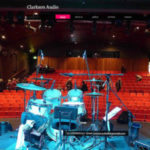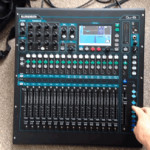Forums › Forums › Qu Forums › Qu general discussions › One musician using Qu16 with three bands
- This topic has 22 replies, 6 voices, and was last updated 7 years, 3 months ago by
 MarkPAman.
MarkPAman.
-
AuthorPosts
-
2017/06/13 at 10:56 am #63859
 SRDParticipant
SRDParticipantHi all,
Just joined this forum and have enjoyed reaping the benefits of all the great info it contains thanks to you all.
I’ve pretty much got to grips with everything my Qu16 running F/W 1.9 has to offer, but just wanted to clarify my understanding of Scenes and Shows and saving thereof.
I play in three separate bands, each using my mixer, and my plan was to allocate 30 scenes to each band in the on board Scenes memory. This would be for different venues primarily, so mainly LR and Mix EQ settings and FX (reverb) parameters would be optimised to a starting point at least.
I also thought about saving Master GEQ settings into a library and naming them after the venue they were used in, again as a starting point only due to audience amount etc.
Am I correct in thinking I don’t need to save anything to my USB hard drive as Shows? I am the only user (with full admin permissions obviously).
Are Shows more for users in the theatre doing multiple scenes in multiple shows, or guys doing multiple bands at multiple festivals?
Thanks in advance for any clarification.
Steve
2017/06/13 at 2:41 pm #63865 Lee7Participant
Lee7ParticipantHi Steve,
All scenes upto 100 are saved within the QU, anymore and you will have to transfer some to a USB stick or HDD. Regarding show scenes, as you have said, these are mainly for shows that have multiple changes, I know a few engineers who use show scenes within their theatre environment.
When I do FOH for multiple band set ups, I would normally set up the FOH eq using some playback music I have and “SAFE” those settings, so when I create a scene for each band and save them, whichever one I load up will always have the L&R eq settings that I had made SAFE earlier. If you don’t do that, everytime you load a new scene up it will overwrite your L&R eq settings with whatever is saved within that scene, so more often than not, a flat eq.
Hope you make sense of what I have tried to say or type?
🙂
2017/06/13 at 5:01 pm #63866 SRDParticipant
SRDParticipantThanks for the quick response Lee7,
The LR EQ will be different for every scene anyway as it will be for our band only, but at different venues. The allocation of 30 scenes to each of my bands is nominal and more than covers the amount of venues we will be playing.
Thanks again for your help.
2017/07/20 at 6:22 pm #64380 coffee_kingParticipant
coffee_kingParticipantHey. I use my desk for two different bands.
I play different venues every gig.
I use scenes but TBH they are more for just keeping input levels, monitor mixes for each different band member and FX settings the same per gig (Its a good starting point anyway). I just dial it back to the last time that band played with me, adjust and save as a new scene.
The band members can each adjust their own IEM mixes with phones/tablets.
I will always EQ a room as I never play the same place twice (Might be different for you but it really doesnt take long to knock out the worst troublesome feedback frequencies)
I doubt you’ll need 30 scenes for each of your 3 bands, you’ll probably just save a new one each time after loading up a previous one.2017/07/21 at 9:57 am #64393 SRDParticipant
SRDParticipantCheers coffee king, the 30 slot allocation is more than enough. I just divided 100 roughly by 3. We do play venues repeatedly but as you say it’s minimal the amount of parameters that need retaining.
2017/07/21 at 11:32 am #64396 Dick ReesParticipant
Dick ReesParticipantUnless ALL conditions are EXACTLY the same each time you retuurn, saving venue specific settings is of questionable value. Are your speakers in exactly the same place down to the inch? Are your microphones in the same exact distance/relationship to the speakers, walls, etc each time? Are there any changes in room decor, audience seating, temperature, humidity?
If a venue does happen to have a bad standing wave at a certain frequency, just make a note of it and address that each time you go in. Even with venue settings saved, they’ll need to be checked each time and it’s always better to do such review from a flat EQ/clean slate.
Your time and effort will be better spent in working with your speaker processing to get the best sound from them in open space, addressing any SYSTEM anomalies with proper DSP.
When you tune your instruments, do you tune it differently according to the room in which you’re playing? I think not. A sound system is likewise an “instrument”. Having it properly processed is not a venue-specific task just as tuning your instruments does not depend on the venue.
2017/07/21 at 10:04 pm #64408 SRDParticipant
SRDParticipantAs I said in my original post, a starting point to save a little time was all I was hoping to gain. I’m aware of the variables, however, I’m not really trying to duplicate the exact acoustics of any given night, just a bit of a headstart when soundcheck times are tight which they often are.
2017/07/22 at 12:03 am #64409 Dick ReesParticipant
Dick ReesParticipantThe greatest time saver would be to find someone who knows how to use SMAART to help you optimize your system. If your system has its own anomalies or peculiarities you’ll have to deal with them as well as the venue every time you set up.
If you have a properly tuned and stabilized speaker system you’ll save a ton of tome and sound better consistently in the process.
2017/07/22 at 1:26 am #64410 Dick ReesParticipant
Dick ReesParticipantIf you’re working with different PA’s all the time, I’d recommend you buy the $50.00 SMAART JR program from Studio Six digital so you can do a quick and accurate setup per venue. It’s much easier when you can look at an on-screen streaming real-time comparison of what’s being output from the Qu and what’s coming out of the speakers.
This is the way to do it these days. Forget trying to store venue settings. Use your scenes for personnel and instruments. With three bands you’d need three scenes. If each band does instrument changes, then each change would add a scene for that band.
2017/07/22 at 1:40 am #64411 Dick ReesParticipant
Dick ReesParticipant(I hate it that the edit function disappears and I have to make an additional post to append info.)
2017/07/23 at 11:41 am #64421 SRDParticipant
SRDParticipantThanks for the heads up Dick. I’ll look into this.
I’m using the same P.A. system every time, but it seems to me it would make a good diagnostic tool as well.
2017/07/24 at 7:40 am #64434 coffee_kingParticipant
coffee_kingParticipantHi
In a nutshell what does this Smaart® Tools app do please (I’ve scanned the link and its not telling me much)?
Surely its not just an RTA which we already have build into the the QU16, so its telling you where the problematic frequencies are so you can drop the GEQ/PEQ on them as we can do this “For free” already.Thanks
2017/07/24 at 11:22 am #64435 Dick ReesParticipant
Dick ReesParticipantSorry. I should have linked directly to the “Single Channel” version.
As stated before, what this shows is a comparison of the sound leaving the mixer and the sound of the audio in the room. This is accomplished by using a measurement mic to return the audio sample back to the program to get an FFT plot. The display options are many, the spectrograph my favorite and of course you are measuring at only one point in the room for real-time analysis, but that’s most likely the mix position anyhow.
The bottom line is that you get a streaming disply similar to the tiny one now available in the latest version, but instead of just the audio leaving the board (“in the box”sound), you’re shown a display of what you’re hearing from the speakers in the listening environment. I’ll see if I can find a video to link.
In the end, this is why it’s called “SMAART”. It’s an analysis made by comparing two things rather than “dumb” displays of just sound from the speaker.
2017/07/24 at 11:42 am #64436 Dick ReesParticipant
Dick ReesParticipantThis is all I could find quickly.
2017/07/24 at 12:59 pm #64437 coffee_kingParticipant
coffee_kingParticipantHey
Im not saying this isnt a great tool (Even though the whole thing sounds way too complicated for me/I dont understand it at all/I dont have time to read up on it anymore)
If all you need is an RTA on your phone/tablet I’d recommend
FFT Plot for £4.99
https://itunes.apple.com/gb/app/fft-plot-real-time-sound-frequency-analyzer/id569468015?mt=8I personally have little to no time to sort the sound for my bands (less than 90 mins from unloading into the room to some background music having to be put on at clients weddings) so for me its always maximum gain before feedback over “Best sounding mix”……
– Set all the band and mics up
– Raise a channel until feedback occurs
– See what the main feedback frequencies are on the built in RTA one by one
– Knock those frequencies down on the GEQ
………and thats itI wish I had more time to do a more thorough job but I really dont.
I’m sure the above app will no doubt be useful for PROPER sound engineers though, not guerrilla sound engineers like myself 🙂
-
AuthorPosts
- You must be logged in to reply to this topic.